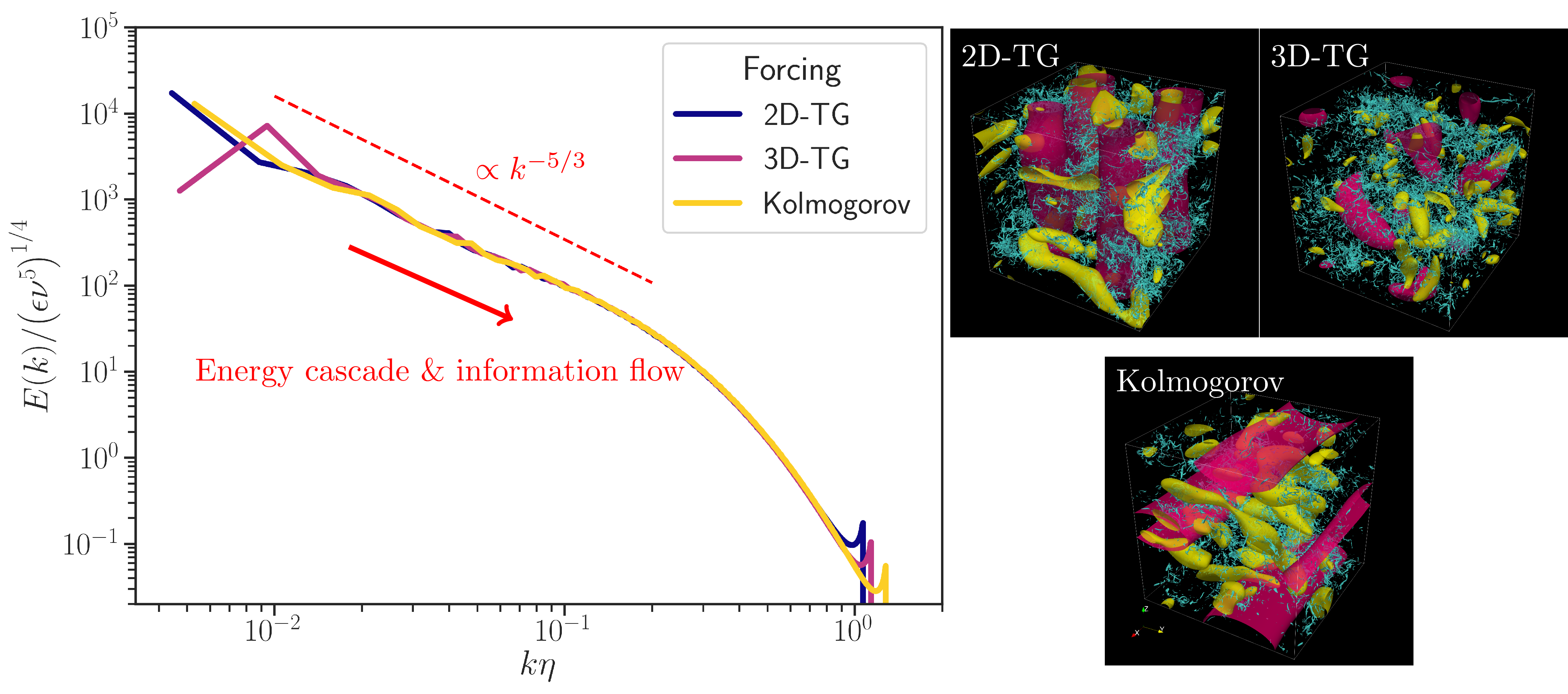Research
日本語で書いた研究紹介はこのページを参照してください.
Information hydrodynamics
Energy cascade and small-scale universality of turbulence
Turbulent flow is a ubiquitous phenomenon in our everyday life. Renowned physicist R. Feynman labelled it as “the most important unsolved problem of classical physics.” Its intricacy makes it impossible for us to accurately forecast tomorrow’s weather or engineer an aircraft with a laminar wing. Turbulence is often described as the superposition of vortices (or eddies) of various scales, as L. F. Richardson depicted it as:
[…] big whirls have little whirls that feed on their velocity, and little whirls have lesser whirls and so on to viscosity […].
This “energy cascade” picture of turbulence, widely accepted in the research community, states that the energy injected in the largest eddies cascades down towards the smaller eddies until the viscosity dissipates into heat.
Besides this captivating picture, the small-scale statistical universality of turbulence plays also a very important role in turbulence research. It states that the statistical characteristics of the small scales (small eddies) of turbulent flow are independent of the macroscopic flow configurations. Thus, whether it is the motion of the atmosphere or the flow around an aeroplane, their small-scale fluctuations exhibit universal statistics. This small-scale universality, introduced by the eminent A. N. Kolmogorov in his 1941 papers, sets the paradigm of turbulence research for more than 80 years.
Furthermore, we believe that the roots of the small-scale statistical universality can be traced back to the energy cascade picture. There is a common schematic description stating that turbulence ‘forgets’ about its macroscopic characteristics during the energy cascade process from larger to smaller scales and its small scales exhibit the universality.
Information theory and turbulence
However, the above description fails to describe the mechanism by which the information content of the large scales of turbulence is lost in the small scales. Furthermore, there should be causality (=information transfer) between the large- and small-scales as the energy cascade picture states that the large-scale eddies create (or provide energy to) the small-scale eddies.
Driven by these intriguing questions, we have been working to construct a new picture of turbulence from the viewpoint of ‘information’. Here, the term information aligns with C. Shannon’s definition in his seminal work on communication through noisy channels, where it serves to quantify the uncertainty of signals. Specifically, we introduce information entropy as the measure of information, with a high entropy indicating events with significant uncertainty, while low entropy corresponds to events with high certainty. Today, this information theory finds applications across various fields of physics.
The information-theoretic viewpoint allows us to reframe various challenges in turbulence. In this text, we address one of them: How do the small scales of developed turbulence forget (or remember) information from the large scales, and to what extent? Beyond this, there are numerous research avenues, from a probabilistic description of laminar-turbulent transition to the development of new turbulence models.
Information thermodynamics and turbulence
Information thermodynamics is a new formulation of thermodynamics that explicitly considers the role of information. It has been playing an important role in the recent advancement of nonequilibrium statistical mechanics, offering solutions to long-standing challenges such as Maxwell’s demon paradox. While it might initially seem inappropriate to combine information thermodynamics and turbulence the fact that hydrodynamics typically deals with scales much larger than microscopic thermal fluctuations, several recent papers insist that the scales influenced by the thermal fluctuations and the smallest scale of turbulence are not as distinctly separated as conventionally thought. They argue that the thermal fluctuations significantly influence the behaviour of the smallest scale of turbulence.
Building upon this discussion, we have been applying the information thermodynamics on turbulence. Recently, we proved the existence of information transfer from large to small scales in turbulence, associated with the energy cascade, by the second law of information thermodynamics. This approach represents a departure from conventional thermofluid dynamics employed in domains like weather prediction and air conditioner design. We further aim to expand information hydrodynamics by taking advantage of the universal laws on information flow discovered by information thermodynamics.

